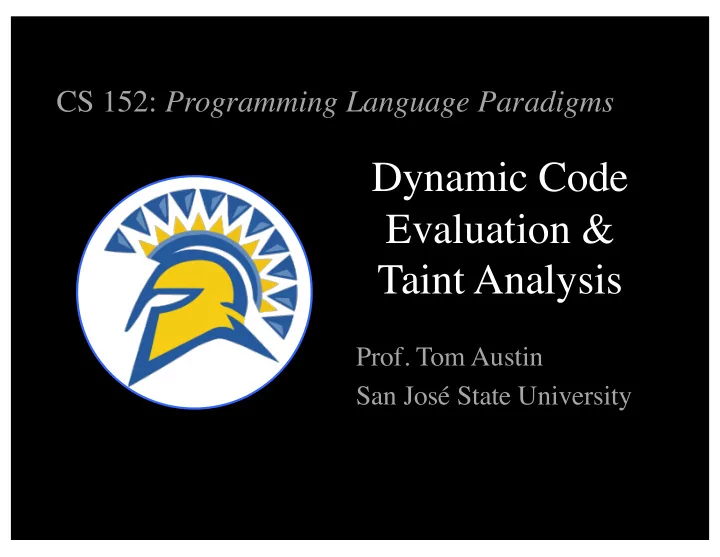

CS 152: Programming Language Paradigms Dynamic Code Evaluation & Taint Analysis Prof. Tom Austin San José State University
Dynamic code evaluation
eval • Executes dynamically • Typically, eval takes a string: eval "puts 2+3" • Popular feature – especially in JavaScript • Richards et al. The Eval that Men Do , 2011 • Source of security problems
Parsing JSON (in-class)
Review: additional Ruby eval methods • instance_eval evaluates code within the body of an object. • class_eval evaluates code within the body of a class. • These methods can take a string or (more safely) a block of code.
class_eval example (in class)
The mind of a developer What does my code Stupid need to do? documentation Hmm… I wonder if my code is secure
Web Security in the News
How do companies/developers cope? • Train/shame developers to follow best practices. • Hire security experts • Use analysis tools • Hush up mistakes • Budget to handle emergencies • Bury their heads in the sand.
Secure By Architecture Developers make mistakes. Can we design tools to create secure systems, despite developer mistakes?
Success story: memory-safe languages • Buffer overflows were once ubiquitous • Memory-safe languages manage memory automatically – Developer focus on functionality – Security-critical bugs are eliminated • Buffer overflows have virtually disappeared – Except in your OS, web browser, etc.
Two Security Mechanisms • Taint analysis : – protect critical fields from "dirty" data • Information flow analysis : – Prevent secrets from leaking.
Taint Analysis: Protecting against dirty data
Taint analysis • Taint analysis focuses on integrity: – does "dirty" data corrupt trusted data? • Integrated into Perl and Ruby • Handles explicit flows only – direct assignment – passing parameters
Attacks preventable by taint analysis • Data under the control of the user may pose a security risk – SQL injection – cross-site scripting (XSS) – cross-site request forgery (CSRF) • Taint tracking tracks untrusted variables and prevents then from being used in unsafe operations
Taint Tracking History • 1989 – Perl 3 support for a taint mode • 1996 – Netscape included support for a taint mode in server-side JavaScript – Later abandoned • Ruby later implemented a taint mode; we'll review in more depth.
Taint Mode in Ruby • Protect against integrity attacks. – E.g. Data pulled from an HTML form cannot be passed to eval . • Cannot taint booleans or ints. • Multiple ways to run in safe mode: – Use –T command line flag. – Include $SAFE variable in code.
$SAFE levels in Ruby • 0 – No checking (default) • 1 – Tainted data cannot be passed to eval – Cannot load/require new files • 2 – Can't change, make, or remove directories • 3 – New strings/objects are automatically tainted – Cannot untaint tainted values • 4 – Safe objects become immutable
s = "puts 4-3".taint $SAFE = 1 # Can't eval tainted data s.untaint # Removes taint from data puts s.tainted? eval s $SAFE = 3 s2 = "puts 2 * 7" # Tainted s2.untaint # Won't work now eval s2 eval s # this is OK
# Data from web s = "Robert'); DROP TABLE " + "STUDENTS;--" s .taint exec_query("SELECT *" + " FROM STUDENTS" + " WHERE NAME='" + s + "';"
class Record def exec_query(query_str) if query_str. tainted? puts "Err: tainted string" else # Perform the query ... end end end
Lab: Taint tracking Today's lab explores taint tracking in Ruby. Starter code is available on the course website. Details in Canvas.
Recommend
More recommend